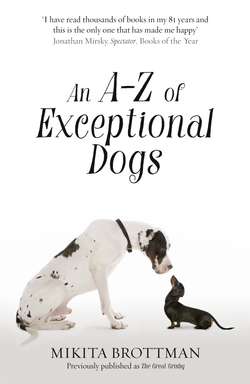Читать книгу An A–Z of Exceptional Dogs - Mikita Brottman - Страница 6
Introduction
Оглавление“UNABLE TO LOVE each other,” writes the British author J. R. Ackerley, “the English turn naturally to dogs.” I acquired my first dog when I was close to forty, and my eight-year love affair with this willful and charismatic animal has led me to wonder whether it’s true, as Ackerley suggests, that there’s something repressed and neurotic about those whose deepest feelings are for their dogs. Thinking about this question has led me not to an answer but to further questions. Is my relationship with Grisby nourishing or dysfunctional, commonplace or unique? Do we choose and train dogs in our own image? Why are some people drawn to poodles, some to bulldogs, and others to dachshunds? Can devotion to a dog become pathological? Why is a woman’s love for her lapdogs considered embarrassingly sentimental when men bond so proudly with their well-built hounds? Married women admit they sleep with their dogs, and married men deny it; someone’s not telling the truth, but who’s lying, and why? What drives some people to wash their hands obsessively after any canine contact while others are happy to share flatware with Fido? And why is “Fido” still used as the generic dog’s name when it’s been out of fashion for almost a hundred years?
Each of this book’s twenty-six chapters is devoted to a particular human-canine bond. Some of these couplings are drawn from literature, where dogs are generally symbolic, often standing as their owners’ avatars, sharing similar characteristics or drawing attention to vital clues that the human characters have overlooked. Other pairings are drawn from history, art, folklore, and philosophy, and cover a broad span of history (320 BC to the 1970s) and geography (Rome, Russia, Japan, Germany, Mexico, Malta, Greece, the United States), but particular attention is paid to dog-and-owner pairs from Victorian Britain. According to authorities on the subject, late-nineteenth-century England saw the origins of modern dog breeding and pet keeping, which led to an increase in the depiction of dogs in art and literature, as well as their increase in everyday life, among all classes and age groups.
Far apart as these human-dog stories may be in time and place, their themes are remarkably consistent. Exceptional dogs, it turns out, often have traits in common, and the most familiar of these is miraculous loyalty. History and folklore are full of dogs that won’t leave their owners’ dead or injured bodies; dogs that spend every night at their masters’ graves; dogs that drown themselves in grief, conceal themselves under their mistresses’ skirts as they’re led to the scaffold, or travel thousands of miles to make their way home. The fact that such tales have become folklore does not mean they are not also true. Dogs are remarkably faithful creatures. Upon further investigation, however, these miraculously loyal dogs often turn out to be rather less miraculous than their stories suggest, though no less interesting for that.
Many of the dogs described in this book will be unfamiliar to the reader, and I’m especially interested in these lesser-known dogs. A lot has been said and written already about iconic, mediagenic dogs like Lassie, Old Yeller, and Rin Tin Tin. In An A–Z of Exceptional Dogs, I draw attention to dogs that inhabit the margins or lurk on the periphery, dogs that have been overlooked. As is so often the case, those who are allowed behind the scenes or on the sidelines (children, servants, janitors, busboys) often get to see and experience things that are normally kept from public view. Partly because they can’t speak but mainly because they don’t judge, dogs have unfettered access to the backstage of life. Imagine what Prince Albert’s dog Eos could have told us about Queen Victoria, or what Freud’s dog Yofi might have learned from his master’s patients. A dog in the room is a silent observer, a witness to the human drama: it sees all, smells all, and says nothing.
All the dogs described in this book are, like Grisby, exceptional. This obviously raises the question of what makes an exceptional dog. The answer is simple. What makes a dog exceptional is its owner. In other words, any dog can be exceptional if it’s loved enough. We see our dogs through human eyes; this is the transformative power of projection. In order to understand this process more fully, I don my psychoanalytic hat and, taking a cue from Freud (another late-life dog lover), I put the human-canine relationship on the couch (never mind the dog hair). The way we think about our dogs is infinitely revealing. Rich insights can be gained from observing how people name their dogs, create personalities for them, address them, speak on their behalf, even from the way they pick up after them. For some, a dog is an alter ego; for others, a substitute for a child; other people use their dogs to keep the world at bay, to heal wounds inflicted in infancy, or to recapture their playful, preverbal selves.
An A–Z of Exceptional Dogs is structured like a leisurely stroll in the park. We begin with Atma, the name given by the misanthropic philosopher Arthur Schopenhauer to his succession of standard poodles, and continue alphabetically until we arrive at Zémire, the adored pet of the French poet and intellectual Madame Antoinette Deshoulières. However, the path is not always direct. In this book, as on all our walks, Grisby sometimes leads us on sidetracks, following scents, sniffing out clues and connections, retracing our steps, taking us into the realms of folklore, semiotics, philosophy, and zoology. Sometimes he seems to be leading us astray, but as long as we’re together, we’ll never be lost. Everywhere, every day, he shows me how dog is the mirror of man.
